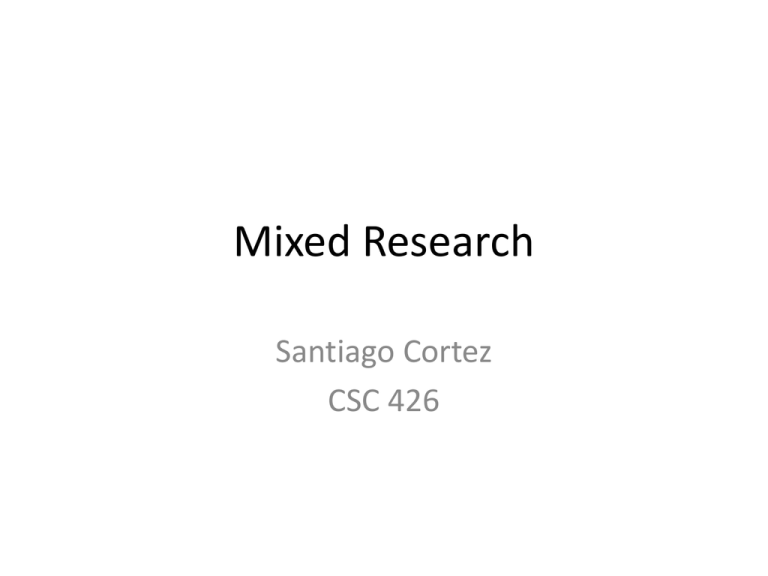Mixed Research
advertisement

Mixed Research Santiago Cortez CSC 426 Quantitative Designs • Quantitative Research: the investigation of phenomena using statistical, mathematical, or computational techniques. In theory specific and narrow questions are posed and data is collected. This data is analyzed using statistics and hopefully provides an unbiased result that can be generalized to a large population. The researcher seeks themes and patterns that are potentially exclusive to the phenomena. Qualitative Designs • Qualitative Research is a non-statistical method of analysis and inquiry of social phenomena. It is inductive (bottom-up) and uses interviews, observations, videotapes, and case studies. It examines and interprets social and human behavior many prior to the formulation of a hypotheses. It is also known as field research and identifies why individuals and groups think and act they way they do. Mixed Research Designs • Mixed Research combines both quantitative and qualitative methods in one overall study. In some types of research there is socially and statistically relevant information that must be processed in order to understand a problem. Many computer science fields such as IS, Project Management, and Disaster Recovery rely just as much on human interaction as statistical or machine performance. Two major types of mixed research • Mixed Method research uses a quantitative approach for one phase and a qualitative approach for another phase. An example would be conducting an interview with participants to gather an opinion after an experiment has been conducted. One study to would determine what happens while the other determines why it happened. Two major types of mixed research • Mixed Model research mixes qualitative and quantitative approaches in the same stage or across multiple stages of the research. An example of is a survey containing closedended (quantitative) and open-ended (qualitative) questions. Advantages of Mixed Research • Weaknesses in one method can be compensated for by strength in another • Can account for a broad range of variables, questions, and hypotheses • Cover holes in the theory • Approach a topic from more than one point of view (strong inference) Advantages of Mixed Research • Can triangulate or cross-examine results. Use different methods to produce the same result. • Can corroborate previously established results. • Can expand a set of results • Can discover data that may have been missed by using only one design • Can identify additional research opportunities Disadvantages of Mixed Research • It is time consuming and expensive • Must have experience in both quantitative and qualitative research • Spend more time on analysis • May be difficult to combine or interpret data • Must experiment to achieve the correct mix How to design your mixed methods research study • Before you start: o What is your philosophy and theory? o Make sure you have sufficient time, resources, and expertise o Identify why you want or need to use mixed research How to design your mixed methods research study • When stating the research problem you must be specific about which questions will be assigned to specific methods and state why that method will satisfy the problem • Coordinate you data collection activities for each part of your study. Be specific about when the data will be collected, analyzed, the weighting of each section, and how it will be combined. How to design your mixed methods research study • Collect your data • Analyze your data • Determine if the combined approach has addressed the research question(s). • If yes continue to final report. • If no, consider what the mixed methods produced that was unexpected and try to determine why. How to design your mixed methods research study • When composing your final report make sure to identify which results were produced by each method and tie them together. Types of designs • Convergent design: merges quantitative and qualitative data and comparing the results • Sequential design: Obtain the results from one data set from build another • Embedded design: insert one design inside of another such as an experiment using individuals and interviews or a questionnaire to uncover the experiences of the participants Types of designs • Multiphase design: different project using different designs conducted over time and linked together. Frequently one phase is a building block for the next. Challenges in Computer Science • Frequently computer science research is built on algorithms, computations, machine design, and performance parameters. There are many other facets that deal with human computer interaction, change management, education, software elicitation, and project management that cannot be adequately captured using traditional quantitative computer science methodologies. My Research • Organizational Liquidity • Serious Games Mixed Research References • Chapter 2, Quantitative, Qualitative, and Mixed Research, http://www.southalabama.edu/coe/bset/john son/lectures/lec2.htm • Research Design: Qualitative, Quantitative, and Mixed Methods Approaches. Creswell, J., 2003 Mixed Research References • U.S. Department of Health and Human Services, Office of Behavioral and Social Sciences Research, Best Practices for Mixed Methods Research in the Health Sciences, The Nature and Design of Mixed Methods Research, Creswell, et al., http://obssr.od.nih.gov/scientific_areas/method ology/mixed_methods_research/section2.aspx Mixed Research References • Weaknesses of Mixed Method Design (Onwuegbuzie & Johnson, 2004)






